Nikon SB-30 User Manual
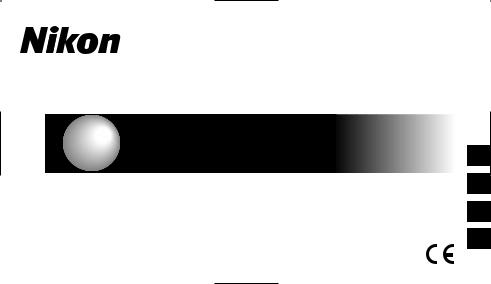
Speedlight
Blitzgerät
Flash
Instruction Manual
Bedienungsanleitung
Manuel d’utilisation
Manual de instrucciones
E
G
F
S

E |
.................English |
1 |
– 034 |
|
Deutsch |
35 |
– 068 |
G |
|||
|
Français |
69 |
– 102 |
F |
|||
|
Español |
103 |
– 136 |
S |

Foreword |
English |
Thank you for purchasing the Nikon Speedlight SB-30.
The SB-30 is a compact, light, and versatile Speedlight having a guide number of 16/52 (at 28mm angle of coverage, ISO 100, m/ft, 20°C/68°F). Available flash shooting modes are TTL auto flash, Non-TTL auto flash, and Manual flash. Wireless multiple flash operation is also possible.
Major features of the SB-30
•The SB-30 is useful as a handy flash unit to perform TTL auto, Non-TTL auto, and Manual flash, when used with Nikon SLRs cameras not having a built-in Speedlight.
•The SB-30 is suitable as a slave flash unit in wireless or wired multiple flash operation when used in
combination with the COOLPIX or Nikon SLRs cameras having a built-in Speedlight.
•Close-up flash photography using with the flash head tilted down is possible without detaching the Speedlight from the camera. Wireless multiple flash operation using the SB-30 as an Infrared remote commander is also possible to control the firing of other slave flash unit(s).
To get the most out of your Speedlight, please read this and your camera instruction manual thoroughly before use.
•Because the SB-30 features the same TTL flash operations as those of the SB-22s, refer to those items in the flash photography section of your camera instruction manual corresponding to SB-22s, if the SB-30 is not listed.
Preparation
E
• (p. xx) indicates the reference page. |
1 |
|

Tips on using the Speedlight
•Take test shots before shooting important occasions like weddings or graduations.
•The Nikon Speedlight SB-30’s performance has been optimized for use with Nikon cameras/ accessories and lenses. Camera/accessories made by other manufacturers may not meet Nikon’s criteria for specifications, and nonconforming cameras/accessories could damage the SB-30’s components. Nikon cannot guarantee the SB-30’s performance when used with non-Nikon products.
Note
•The Nikon N90s, N90, N70, N60, N55, N50, N8008, N8008s, PRONEA 6i, N6006, N6000, N5005, N4004, and N4004s are sold exclusively in the U.S.A.
•The Nikon N80-Series and N65-Series are sold exclusively in the U.S.A. and Central and South America.
•The Nikon N2020 and N2000 are sold exclusively in the U.S.A and Canada.
Warning
•Batteries shall not be exposed to excessive heat such as sunshine, fire or the like.
•Dry batteries shall not be subjected to charging.
•Do not expose the SB-30 to water as this may result in electric shock or cause the unit to catch on fire.
2

Contents |
|
Preparation |
|
Foreword ............................................................. |
1 |
Tips on using the Speedlight .............................. |
2 |
Speedlight parts.................................................. |
4 |
Mode selector dial .............................................. |
5 |
Flash head tilting angle....................................... |
5 |
Installing the battery............................................ |
6 |
Turning the power ON/OFF and the Standby function ........ |
7 |
Attachment to the accessory shoe ..................... |
9 |
Usable cameras and available flash modes..... |
10 |
Using the SB-30 with SLRs cameras |
|
As a handy Speedlight |
|
Auto flash modes .............................................. |
12 |
TTL auto flash mode...................................... |
12 |
Non-TTL auto flash mode .............................. |
13 |
Manual flash mode............................................ |
18 |
Illuminating a distant subject using the SB-30 |
|
and cameras such as the COOLPIX |
|
Wireless slave flash shooting............................ |
20 |
Shooting a distant subject using the SB-30 in |
|
conjunction with cameras such as the COOLPIX |
|
that have a built-in Speedlight .............................. |
22 |
Shooting a subject when the SB-30 is placed away |
|
from the camera ................................................ |
24 |
Softening the shadows cast on the wall by the |
|
master flash unit or lightening the background.......... |
26 |
Multiple flash operation using the SB-30 as an |
|
infrared remote commander .......................... |
27 |
Multiple flash shooting using cords .................. |
27 |
Advanced operation |
|
Close-up flash operation from approx. 0.3 to 1m |
|
(1 to 3.3 ft.) with the built-in wide-flash adapter ..... |
28 |
Exposure compensation ................................... |
30 |
Reference information |
|
Optional accessories ........................................ |
31 |
Troubleshooting ................................................ |
32 |
Tips on Speedlight care and Notes on batteries...... |
33 |
Specifications.................................................... |
34 |
Preparation
E
3
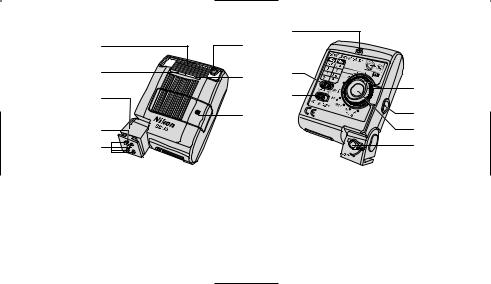
Speedlight parts |
|
9 |
|
1 |
6 |
|
|
|
|
||
2 |
7 |
10 |
|
|
|
12 |
|
3 |
|
11 |
|
|
13 |
||
|
8 |
|
|
4 |
|
|
14 |
5 |
|
|
15 |
1 |
Flash head |
8 |
Battery chamber lid |
14 |
Standby resume button (p. 8)/Slave |
2 |
Infrared filter (p. 27) |
9 |
Ready-light (pp. 7, 13) |
|
flash firing cancel button (p. 23) |
3 |
Mounting foot |
10 |
Exposure compensation |
15 |
Mounting foot lock lever (p. 9) |
4 |
Mount pin |
|
switch (p. 30) |
|
|
5 |
Hot-shoe contacts |
11 |
Power switch (p. 7) |
|
|
6 |
Light sensor window for |
12 |
Mode selector dial (p. 5) |
Supplied accessories |
|
|
Non-TTL auto flash (p. 13) |
13 |
Light sensor window for |
Soft Case SS-30 |
|
7 |
Built-in wide-flash adapter |
|
wireless slave flash |
|
|
4 |
(p. 28) |
|
(pp. 20-26) |
|
|
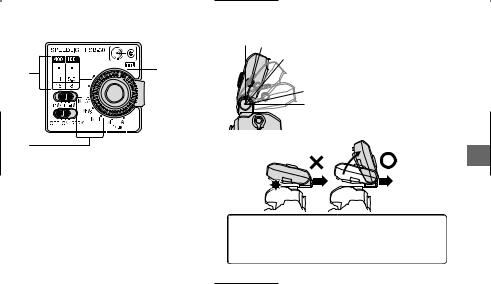
Mode selector dial
2 
 1
1
3  4
4
1TTL auto flash mode (pp. 12, 14)
2Non-TTL auto flash mode (pp. 13, 16)
3Manual flash mode (p. 18)
4Wireless slave flash mode (p. 20)
Flash head tilting angle
75
50 |
|
75°: for shooting normal |
|
|
|
subjects |
|
|
|
50°: for shooting subjects |
|
|
13 |
closer than 0.4m (1.3 ft.) |
Preparation |
|
(p. 29) |
||
|
|
||
|
|
|
13°: when not in use.
E
CAUTION!
Do not detach the flash unit while it is set at the 13° position. Otherwise, the flash unit or camera
might get scratched.
5

Installing the battery
1 |
2 |
3 |
1 Set the SB-30’s power switch to the OFF position.
2 Open the battery chamber lid as indicated by the arrows.
3 Install the battery following the + and – marks as shown. Then close the battery chamber lid by sliding it into place while pressing down.
•Install one 3V lithium battery (CR123A or DL123A). Do not use the other types of batteries.
•When replacing the battery, be sure to set the power switch to the OFF position. If the battery is replaced while the power switch is set to the ON or STBY (standby) position, the Speedlight may fire accidentally or the power may not turn on correctly. In this case, set the SB-30’s power switch to the OFF position once, then set it back to the ON or STBY position. (p. 7)
Battery performance
•When using a fresh battery, the number of flashes when the SB-30 fires at M1/1 output is approx. 250 times.
•With a fresh battery, the recycling time after the SB-30 fires at M1/1 output is approx. 4 seconds.
•Replace the battery, if the ready-light takes more than 30 seconds to light up when the unit first turned 6 on or after firing the unit.
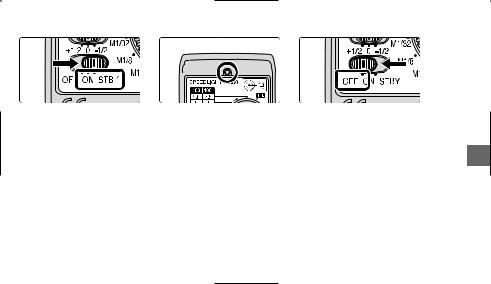
Turning the power ON/OFF and the Standby function
1 |
2 |
3 |
1 Set the SB-30’s power switch to the ON or STBY position.
•When set to the STBY position the Standby function is activated. (p. 8)
•The Standby function does not work with COOLPIX digital cameras having no hot-shoe contacts. In this case, set the SB-30 to the ON position.
2 Make sure the ready-light comes on.
• When the ready-light lights up, the SB-30 is fully recycled and ready to fire.
3 Set the SB-30’s power switch to the OFF position when not in use.
• Be sure to set the SB-30’s power switch to the OFF position when not in use to conserve battery power.
Preparation
E
7

Conserving battery power using the Standby function
•If the SB-30’s power switch is set to the STBY position, the Standby function is activated only when the Mode selector dial is set to either TTL auto, Non-TTL auto, or Manual flash mode.
•If the SB-30 and the camera are not used for approx. 40 seconds, the Standby function activates and automatically turns the SB-30 off to conserve battery power. This is called the standby state.
•The Standby function does not work if the Mode selector dial is set to the Wireless slave flash mode. Take care that the power remains on and is consuming.
To turn the SB-30 on again after it enters in the standby state, you can:
•Press the Standby resume button/Slave flash firing cancel button.
•Lightly press the shutter release button on a camera that is compatible with the TTL auto flash mode.
8

Attachment to the accessory shoe
Attaching and detaching the Speedlight
Slide the SB-30’s mounting foot 1 into the camera’s accessory shoe, then turn the lock lever 2 in the direction of the arrow to lock the unit.
•When the SB-30 is attached to an accessory shoe not equipped with a mount pin hole to prevent accidental detachment, take care that the SB-30 does not fall off.
•When detaching the SB-30, set the flash head tilting angle to 75° or 50°, turn the lock lever 90° in the opposite direction to unlock the unit, then pull the Speedlight off.



 Preparation
Preparation
E
Note on attaching the SB-30 to cameras that have a built-in Speedlight
When the SB-30 is attached to the camera’s accessory shoe, do not pop-up the camera’s built-in Speedlight. Otherwise, only one of the Speedlights will fire. However, this is not a malfunction.
9

Usable cameras and available flash modes
Available flash modes with film-based SLRs cameras
: Recommended flash mode ○: Usable flash mode ×: Not usable : Not applicable
With a built-in flash Without a built-in flash
*1 *2 *3
10 *4
Camera type and model |
Connection |
|
Mode selector dial settings |
|
||||
|
|
to the camera |
TTL auto |
Non-TTL auto |
Manual |
Wireless (M) |
Wireless (A) |
|
Cameras compatible with the TTL auto flash mode: |
|
|
|
|
|
|
||
F5, F4-Series, F100, F90X/N90s, F90-Series/N90, F-801s/N8008s, |
Accessory |
○ |
○ |
|
|
|||
F-801/N8008, F-601M/N6000, F-501/N2020, F-301/N2000, FM3A, FA, FE2, |
shoe |
p . 14 |
||||||
FG, F3-Series*1 |
|
|
|
|
|
|
||
Cameras incompatible with the TTL auto flash mode: |
Accessory |
× |
|
○ |
|
|
||
F2*2, FM2, New FM2, FE, FG20, EM, FM10, FE10 |
||||||||
shoe |
|
p .16 |
|
|
|
|||
Cameras with an accessory shoe: |
Accessory |
○ |
○ |
|
|
|||
F80-Series/N80-Series*4, F70-Series/N70*4, F65-Series/N65-Series, |
|
shoe |
p .14 |
|||||
F60-Series/N60, F55/N55*3, F50-Series/N50, F-601/N6006, |
Wireless |
|
|
|
|
|
||
F-401x/N5005, F-401s/N4004s, F-401/N4004, Pronea 600i/6i |
p .21 |
p .21 |
||||||
Cameras without an accessory shoe: |
Wireless |
|
|
|
|
|
||
Pronea S |
p .21 |
p .21 |
||||||
|
|
|
|
|
|
|
|
|
Optional TTL Flash Unit Coupler AS-17 is required. Optional TTL Flash Unit Coupler AS-1 is required.
TTL auto flash is not possible when the SB-30 is mounted on the accessory shoe. Set the flash mode to the Non-TTL auto. Set the camera’s exposure mode to Manual when the built-in Speedlight is used as a master flash unit.

Available flash modes with digital cameras
|
|
: Recommended flash mode |
○: Usable flash mode |
×: Not usable : Not applicable |
|||||
|
Camera type and model |
|
|
Connection |
|
Mode selector dial settings |
|
||
|
|
|
to the camera |
TTL auto |
Non-TTL auto |
Manual |
Wireless (M) |
Wireless (A) |
|
|
|
|
|
||||||
D1-Series*1, D100 |
|
|
Accessory |
× |
|
○ |
|
|
|
|
|
shoe |
p .16 |
||||||
|
|
|
|
|
|
|
|
||
COOLPIX 5000/5700 |
|
|
Accessory |
|
○ |
○ |
|
|
|
|
|
shoe |
p .14 |
||||||
|
|
|
|
Cord*2*3 |
|
○ |
○ |
|
|
|
|
|
|
p .14 |
|||||
COOLPIX 900/910/950/990/995/4500 |
|
|
|
|
|
|
|
||
|
|
Wireless*4 |
|
|
|
|
|
||
|
|
|
|
||||||
|
|
|
|
p .21 |
p .21 |
||||
|
|
|
|
|
|
|
|
|
|
COOLPIX*5 700/775/800/880/885/2000/2500/3500/4300 |
|
|
Wireless*4 |
|
|
|
× |
|
|
|
|
p .21 |
|||||||
|
|
|
|
|
|
|
|
|
|
|
|
|
|
|
|
|
|
|
|
COOLPIX 100/300/600*6/5000*7/5700 |
|
|
Wireless*4 |
|
|
|
|
|
|
|
|
p .21 |
p .21 |
||||||
|
|
|
|
|
|
|
|
||
*1 |
The D-TTL auto flash mode is not possible with the SB-30. |
*5 |
The built-in flash fires one preliminary flash before actually |
|
|
||||
*2 |
Except the COOLPIX 900 |
*6 |
firing to produce the correct flash output. |
|
|
|
|||
*3 |
Use of the Multi-Flash Bracket Unit SK-E900 is recommended. |
A dedicated Speedlight for the COOLPIX 600 is required. |
|
|
|||||
*4 |
Use of the Bracket Set SK-9 is recommended. |
*7 |
At the “Auto with red-eye reduction” setting, the Wireless (M) mode is not possible. |
||||||
|
|
|
Use the Wireless (A) mode instead. |
|
|
|
|
||
Preparation
E
11

Using the SB-30 with SLRs cameras As a handy Speedlight
Auto flash modes
Two auto flash modes are available with the SB-30: TTL auto flash and Non-TTL auto flash
TTL auto flash mode
Available TTL auto flash modes such as Multi-Sensor Balanced Fill-Flash, Center-Weighted Fill-Flash/Spot Fill-Flash, or Standard TTL flash vary, lenses in use. For details, refer to your camera’s instruction manual.
•3D Multi-Sensor Balanced Fill-Flash is not possible, because the SB-30 does not (Monitor Preflash).
•The D-TTL auto flash mode is not possible with the SB-30.
12

Non-TTL auto flash mode
This mode is possible with all Nikon SLRs cameras including Digital SLRs. At the instant the shutter is released and the SB-30 starts firing, the SB-30’s built-in light sensor for Non-TTL auto flash measures the flash illumination that is reflected back from the subject, automatically controlling the SB-30’s flash output to provide the correct exposure. Therefore, auto flash shooting is possible with cameras incompatible with TTL auto flash. A choice of four shooting apertures is available: f/2.8, f/4, f/5.6, and f/8
at ISO 100, and f/5.6, f/8, f/11, and f/16 at ISO 400.
Insufficient flash light warning indication in auto flash
When the flash has fired at its maximum output and underexposure have occurred, the ready-light blinks for approx. 1.5 sec. To
use a wider aperture or move closer to the subject and reshoot
Basic operation
E
13

Taking flash pictures in the TTL auto flash mode
1 |
2 |
4 |
1 Set the SB-30’s Mode selector dial to D.
2 Set the camera’s exposure mode, metering system, sync mode, shutter speed, etc.
•The ready-light inside the camera’s viewfinder blinks to warn you that the setting on the camera is not correct and TTL auto flash is not possible. In this case, make sure the camera settings are correct.
3 Check the aperture and flash shooting distance range.
•Make sure the main subject is within this range by referring to the table “Determining the aperture and flash shooting distance range” (p. 15).
•If the camera’s exposure mode is set to Aperture-Priority Auto (A) or Manual (M), set one of the appropriate apertures obtained from the table on the camera.
4 Make sure the SB-30’s ready-light is on, then shoot.
• Refer to page 13 if the ready-light inside the camera’s viewfinder blinks after shooting.
14

Determining the aperture and flash shooting distance range (m/ft.)
|
|
|
|
ISO sensitivity |
|
|
Flash shooting distance range (m/ft.) |
|||
|
|
25 |
50 |
100 |
200 |
400 |
800 |
No wide-flash adapter in place |
With wide-flash adapter in place |
|
|
|
|
f/1.4 |
f/2 |
f/2.8 |
f/4 |
f/5.6 |
1–8/3.3–26 |
0.7–5/2.3–16 |
|
TTL-Non |
flashauto |
f/1.4 |
f/2 |
f/2.8 |
f/4 |
f/5.6 |
f/8 |
0.7–5.6/2.3–18 |
0.5–3.5/1.6–11 |
|
|
|
|
|
|
|
|
|
|||
f/2 |
f/2.8 |
f/4 |
f/5.6 |
f/8 |
f/11 |
0.6–4/2–13 |
0.3–2.5/1–8.2 |
|||
|
|
|||||||||
|
|
|
|
|
|
|
|
|
|
|
|
|
f/2.8 |
f/4 |
f/5.6 |
f/8 |
f/11 |
f/16 |
0.6–2.8/2–9.1 |
0.3–1.7/1–5.5 |
|
|
|
f/4 |
f/5.6 |
f/8 |
f/11 |
f/16 |
f/22 |
0.6–2/2–6.5 |
0.3–1.2/1–3.9 |
|
|
|
|
|
|
|
|
|
|
|
|
|
|
f/5.6 |
f/8 |
f/11 |
f/16 |
f/22 |
f/32 |
0.6–1.4/2–4.5 |
0.3–0.8/1–2.6 |
|
|
|
f/8 |
f/11 |
f/16 |
f/22 |
f/32 |
|
0.6–1/2–3.2 |
0.3–0.6/1–1.9 |
|
•At an ISO sensitivity of 100 (200), the available shooting apertures in the Non-TTL auto flash mode are: f/2.8, f/4, f/5.6, and f/8 (f/4, f/5.6, f/8, and f/11)
• At an ISO sensitivity of 100 (400), the available shooting apertures in the TTL auto flash mode are: f/2 to f/16 (f/4 to f/32).
•Use of the built-in wide-flash adapter is recommended when shooting subjects closer than approx. 1m (3.3 ft.) (p. 28)
•Set the flash head at the 50° position when shooting subjects closer than approx. 0.4m (1.3 ft.) (p. 5).
TTL auto flash |
Basic operation |
E
15
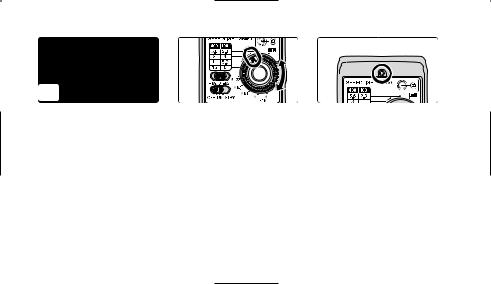
Taking flash pictures in the Non-TTL auto flash mode
 1
1
the camera’s exposure mode, sync mode, shutter speed, etc.
ready-light inside the camera’s viewfinder blinks to warn you that the shutter speed is not correctly set cameras FM3A, New FM2, and FE. In this case, make sure the camera settings are correct.
the correct aperture to match the shooting distance range by referring to the table
the aperture and flash shooting distance range” (p. 15). Set the same aperture on the 30’s Mode selector dial.
the available apertures, refer to the table “Determining the aperture and flash shooting distance
.” (p. 15)
the same aperture on the camera or lens as set on the SB-30. the correct exposure cannot be obtained.
using a zoom lens having a variable aperture, refer to “Variable apertures after zooming in or out”
. 17) before setting the aperture.
sure the SB-30’s ready-light is on, then shoot.
16 |
to page 13 if the ready-light inside the camera’s viewfinder blinks after shooting. |

Variable apertures after zooming in or out
•With zoom lenses having a variable aperture, take note of the following before setting the aperture on the SB-30.
•For details, refer to your camera and lens instruction manuals.
Reading the aperture on the camera’s LCD panel or in the viewfinder
•Lock the lens aperture at its minimum, and after composing the picture by zooming in or out, read the aperture appearing on the camera’s LCD panel or in the viewfinder.
Reading the aperture using the scale on the lens
•After zooming in or out to select the appropriate composition, read the aperture in the following way:
At wideangle zoom settings, read the aperture value at the green index (or line). At telephoto settings, read the aperture value at the yellow index (or dot).
At intermediate settings, read the aperture value between the two indexes.
Basic operation

Manual flash mode
The SB-30’s flash output level can be set manually at M1/1, M1/8, or M1/32. In the Manual mode, you must determine the correct exposure by calculation using a combination of the guide number, shooting distance, and lens aperture.
•If the camera’s exposure mode is set to other than Aperture-Priority Auto (A) or Manual (M), the shutter may not be released, depending on the cameras in use.
Guide number (m/ft.) and ISO sensitivity
|
ISO sensitivity |
|
25 |
50 |
100 |
200 |
400 |
800 |
1600 |
|
Flash output level |
M1/1 |
8/26 |
11/36 |
16/52 |
22/72 |
32/105 |
45/148 |
64/210 |
|
M1/8 |
2.8/9 |
4/13 |
5.6/18 |
8/26 |
11/36 |
16/52 |
22/72 |
|
|
|
M1/32 |
1.4/4.6 |
2/6.6 |
2.8/9.2 |
4/13 |
5.6/18 |
8/26 |
11/36 |
|
|
M1/1 |
5/16 |
7.1/23 |
10/33 |
14/46 |
20/66 |
28/92 |
40/131 |
|
Flash output level |
M1/8 |
1.8/5.9 |
2.5/8.2 |
3.5/11 |
5/16 |
7.1/23 |
10/33 |
14/46 |
|
(with wide-flash adapter in place) |
|
|
|
|
|
|
|
|
|
M1/32 |
0.9/3 |
1.3/4.3 |
1.8/5.9 |
2.5/8.2 |
3.5/11 |
5/16 |
7.1/23 |
|
|
|
||||||||
|
• To obtain the correct exposure, use the following equations to determine the aperture and guide number to match the |
||||||||
|
flash shooting distance. |
|
|
|
|
|
|
|
|
|
f/stop (aperture) = Guide number (GN) ÷ Shooting distance (m/ft) |
|
|
|
|
||||
|
Guide number (GN) = Aperture x Shooting distance (m/ft) |
|
|
|
|
||||
|
• For example, when shooting a subject at a distance of 2.5m (8.2 ft), at an ISO sensitivity of 400 and a lens aperture of f/2.8: |
||||||||
|
Guide number = 2.8 x 2.5 = 7 (in meters) or 2.8 x 8.2 = approx. 23 (in feet). |
|
|
|
|||||
|
Therefore M1/8 is the correct flash output level with the wide-flash adapter in place. |
|
|
|
|||||
18 |
• Likewise, when shooting a subject at a distance of 4m (13 ft.), at an ISO sensitivity of 400 and M1/1 flash output level |
||||||||
without using the wide-flash adapter: |
|
|
|
|
|
|
|
||
|
f/stop = 32 ÷ 4 = 8 (in meters) or 105 ÷ 13 = approx. 8 (in feet). Therefore, f/8 is the correct lens aperture. |
||||||||
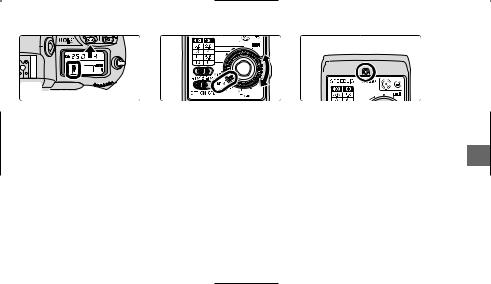
Taking flash pictures in the Manual flash mode
1


1 |
Set the camera’s exposure mode, sync |
speed, etc. |
2 |
Determine the aperture and flash output level to match the flash shooting distance. |
|
•The guide number varies as shown in the guide number table on page 18, depending on the flash output level with and without the wide-flash adapter in place.
3 Set the aperture on the camera or lens and the flash output level on the SB-30.
4 Make sure the SB-30’s ready-light is on, then shoot.
•In the Manual flash mode, no warning ready-light blinks to indicate that the light may have been insufficient for correct exposure after shooting.
Basic operation
E
19

Illuminating a distant subject using the SB-30 and cameras such as the COOLPIX
Wireless slave flash shooting
In this section, the SB-30 is used as a slave flash unit that starts and stops firing in sync with the master Speedlight mounted on the camera or the camera’s built-in Speedlight. With the SB-30, the following types of wireless slave flash shooting can be performed.
•The Standby function does not work if the Mode selector dial is set to the Wireless slave flash mode. Take care that the power remains on and is consuming.
Shooting a distant subject using cameras such as the COOLPIX that have a built-in Speedlight (P. 22)
By placing the camera and the SB-30 side-by-side to fire the SB-30 in sync with the built-in Speedlight, you can illuminate a distant subject, creating a picture not possible when using the built-in flash by itself.
Using the SB-30 as a slave flash unit placed away from the camera (p. 24)
In multiple flash, when the SB-30 is used away from the camera, you can create more natural-looking pictures with sufficient illumination throughout the picture.
Softening shadows cast on the wall by the master flash unit or lightening the background (p. 26)
By using the SB-30 at full (M1/1) output, you can eliminate unattractive shadows or lighten the background to create more natural-looking pictures.
Multiple flash operation using the infrared remote commander (p. 27)
With the built-in infrared filter in place, the SB-30 operates as an infrared remote commander to trigger 20 other slave flash units.
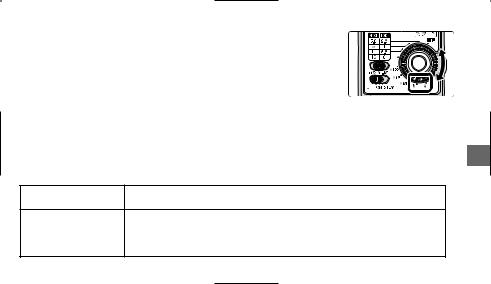
Two methods of wireless slave flash shooting
Wireless slave flash can be performed in two ways by setting the Mode selector dial:
(1) Auto wireless slave flash (A) mode:
• The SB-30 starts and stops firing in sync with the master Speedlight.
• The maximum shooting distance of the SB-30’s light sensor is approx. 5m (16 ft.).
(2) Manual wireless slave flash (M) mode:
•The SB-30 only fires at M1/1 output in sync with the master Speedlight.
•The maximum shooting distance of the SB-30’s light sensor is approx. 40m (131 ft.)
Notes
•Position the slave flash unit (SB-30) so that light from the master flash unit can reach slave flash unit. This is particularly important when taking pictures while holding a
•The correct exposure cannot be obtained if the master Speedlight fires a series of Cancel the Monitor Preflash of the master flash unit using the methods described below except for the one preliminary flash firing of the COOLPIX that does not affect the
F80-Series/N80-Series, Set the camera’s exposure mode to Manual (M)
F70-Series/N70
F5, F100, F90X/N90s, |
Cancel the Monitor Preflash of the Speedlight mounted on the camera. |
F90-Series/N90 |
|
D1-Series |
Set the flash mode of the Speedlight mounted on the camera to Non-TTL auto |
|
or Manual flash. |
Basic operation
E
21

Shooting a distant subject using the SB-30 in conjunction with cameras such as the COOLPIX that have a built-in Speedlight
By placing the camera and SB-30 side-by-side to fire the SB-30 in sync with the built-in Speedlight, you can illuminate a distant subject, creating pictures not possible when using the built-in Speedlight alone. Set the SB-30’s Mode selector dial to the Wireless slave flash (A) mode to perform auto flash.
•The COOLPIX 900, COOLPIX 700 series, COOLPIX 800 series and COOLPIX 2500 cameras that fire one preliminary flash are usable.
•With the Pronea S that has no accessory shoe or the F55/N55, which has a hot shoe but no TTL auto flash function, the SB-30 can still perform TTL auto flash.
•When attaching the SB-30 to cameras such as COOLPIX 700 series, COOLPIX 800 series, using the optional Bracket Set SK-9, refer to the SK-9 instruction manual.
|
Main subject |
Slave flash |
Bracket Set |
unit:SB-30 |
|
|
SK-9 (optional) |
Camera: COOLPIX 700 series, COOLPIX 800 series, COOLPIX 2500, etc.
Master flash unit: Built-in Speedlight
22

Taking flash pictures with the COOLPIX
1 Make the necessary settings on the camera as with a normal Speedlight.
2 Set the SB-30’s Mode selector dial to Wireless slave flash (A).
•In wireless slave flash shooting, exposure compensation using the SB-30’s Exposure compensation switch is not possible. In this case, make exposure compensation on the camera.
3 Check the aperture and flash shooting distance, then shoot.
•Press the Standby resume button/Slave flash firing cancel button to avoid accidental firing in sync with other Speedlights. The SB-30 will not fire, while this button is pressed.
Taking flash pictures using film-based SLRs cameras
1 Set the master Speedlight, either the built-in Speedlight or one mounted on the camera, to fire.
• Be sure to cancel the master flash unit’s Monitor Preflash (p. 21).
2 Use the SB-30 as the slave flash unit and set it to the Wireless slave flash (A) mode.
•In wireless slave flash shooting, exposure compensation using the SB-30’s Exposure compensation switch is not possible. In this case, make exposure compensation on the camera.
3 Check the aperture and flash shooting distance, then shoot.
•Press the Standby resume button/Slave flash firing cancel button to avoid accidental firing in sync with other Speedlights. The SB-30 will not fire, while this button is pressed.
Basic operation
E
23

Shooting a subject when the SB-30 is placed away from the camera
When the SB-30 is placed away from the camera to perform multiple flash, you can take more naturallooking pictures with sufficient illumination. Set the SB-30’s Mode selector dial to Wireless salve flash (A) to perform wireless multiple flash operation in the TTL auto or Non-TTL auto flash mode.
•The COOLPIX 900, COOLPIX 700 series, COOLPIX 800 series and COOLPIX 2500 cameras that fire one preliminary flash are usable.
•Speedlights such as the SB-30, SB-80DX, SB-50DX, etc. that feature a wireless multiple flash function can be used as the slave flash unit. Also, any other Speedlight compatible with TTL auto flash, when mounted on the optional Wireless Slave Flash Controller SU-4, is usable.
•In the wireless slave flash (A) mode, the maximum shooting distance of the SB-30’s light sensor is approx. 5m (16 ft.).
•Position the slave flash unit so that light from the master flash unit only reaches the light sensor of the slave flash unit. If too much light from other slave flash units enters the light sensor of the slave flash unit directly or indirectly, correct operation may not be possible
24
Slave |
Main subject |
|
Slave |
||
flash |
||
unit 1: SB-30 |
flash |
|
|
unit 2* |
Camera: All Nikon SLRs and Digital cameras.
Master flash unit: Built-in Speedlight or Speedlight mounted on the camera
*Any Speedlight compatible with TTL auto flash when mounted on the optional Wireless Slave Flash Controller SU-4.

Taking flash pictures
1 Make the necessary settings on the camera as with a normal Speedlight.
2 Set the SB-30’s Mode selector dial to Wireless slave flash (A).
•In wireless slave flash shooting, exposure compensation using the SB-30’s Exposure compensation switch is not possible. In this case, make exposure compensation on the camera.
3 Set the master Speedlight’s flash mode to TTL auto flash.
•Be sure to cancel the master Speedlight’s Monitor Preflash (p. 21).
•If Monitor Preflash cannot be canceled, set the flash mode to other than the TTL auto flash mode.
•The D-TTL auto flash mode is not possible with the SB-30. With Digital SLRs cameras, set the flash mode to Non-TTL auto flash or Auto Aperture flash.
4 Check the aperture and flash shooting distance, then shoot.
Basic operation
E
25

Softening the shadows cast on the wall by the master flash unit or lightening the background
Set the SB-30’s Mode selector dial to Wireless slave flash (M), and the Speedlight will fire at M1/1 output, allowing you to eliminate shadows or lighten the background for creating more natural-looking pictures.
•The maximum shooting distance of the master Speedlight’s light sensor is approx. 40m (131 ft.).
Taking flash pictures
1 Use the SB-30 as the slave flash unit and set it to the Wireless slave flash (M) mode.
2 Determine the correct exposure using the flash-to- subject distance and aperture set on the camera or lens, then shoot.
•Refer to “Manual flash mode” on page 18.
•To eliminate shadows such as those cast on the wall, use a lens aperture that makes the illumination on the wall overexposed by the equivalent of at least +2 stops.
Wall
Shadows
Main subject
Slave flash
unit 1: SB-30
Camera: All SLRs cameras
Master flash unit: Speedlight mounted on the camera or the camera’s built-in Speedlight.
26
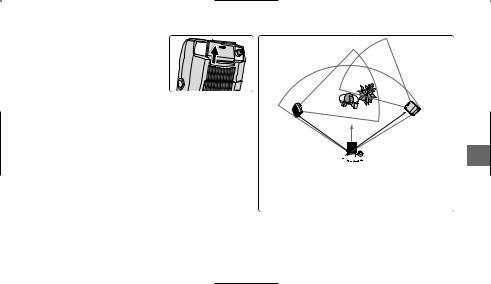
Multiple flash operation using the SB-30 as an infrared remote commander
With the built-in infrared filter in place, you can use the SB-30
as an infrared remote commander to perform wireless multiple flash, using slave flash units only to illuminate the subject without the use of a master flash unit.
•Set the flash mode to TTL auto flash; flash is not recommended.
•The infrared filter can be used together with the wide-flash adapter.
•Even though light leaks from both sides of the infrared filter, this will not affect the correct exposure.
•Without using the infrared filter, the master flash unit works as a normal flash unit and the subject is also illuminated by this flash unit.
Slave flash
unit 1: SB-30
Infrared
light
|
Slave |
|
Main subject |
flash |
|
unit 2* |
||
|
Infrared Infrared light
light
 Camera: SLRs or Digital cameras,
Camera: SLRs or Digital cameras,
Master flash unit: SB-30
*Any Speedlight compatible with TTL auto flash when mounted on the optional Wireless Slave Flash Controller SU-4.
Multiple flash shooting using cords
Basic operation
E
Like other Speedlights compatible with the TTL auto flash mode, the SB-30 can perform TTL multiple flash |
|
using optional TTL Remote Cords SC-17/SC-24, TTL Multi-Flash Sync Cords SC-18/SC-19, or the TTL Multi- |
27 |
Flash Adapter AS-10. For details, refer to your camera or accessory instruction manuals or brochures. |
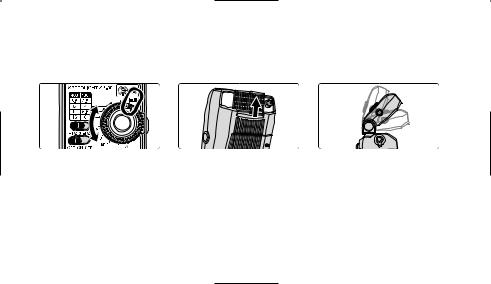
Close-up flash operation from approx. 0.3 to 1m (1 to 3.3 ft.) with the built-in wide-flash adapter
With the SB-30 attached to the camera’s accessory shoe, close-up flash shooting can be performed.
•Be sure to use the built-in wide-flash adapter when taking close-up flash photographs.
•Vignetting may occur in close-up flash shooting when using a large diameter lens, lens hood, etc.
1 |
3 |
4 |
1 Set the SB-30’s Mode selector dial to t.
•With cameras incompatible with the TTL auto flash mode, set the dial to the Non-TTL auto flash or Manual flash mode.
2 Set the camera’s exposure mode, metering system, sync mode, shutter speed, etc.
•The ready-light in the camera’s viewfinder blinks to warn you that the settings on the camera are not correct and TTL auto flash is not possible. In this case, check the camera’s settings.
3 Set the wide-flash adapter in place by pulling it up.
• Take care that the black infrared filter does not obscure the front of the flash adapter.
28
